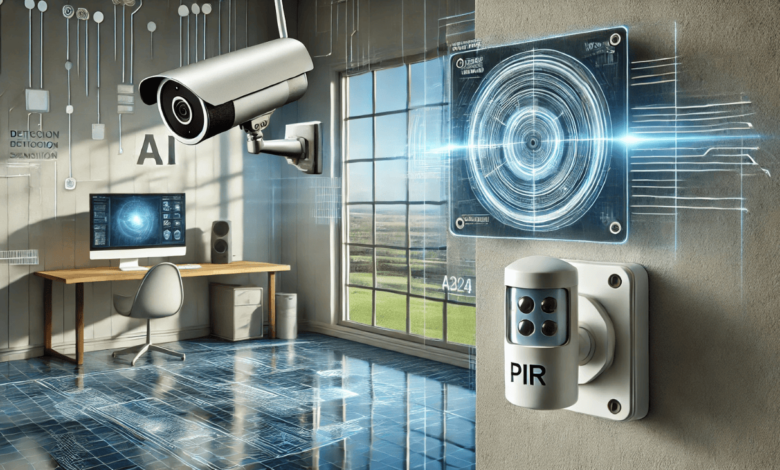Can AI PIR Sensor Detect Motion Through a Window? The Truth Revealed

Motion detection technology has evolved dramatically, particularly with the integration of artificial intelligence (AI). One of the most commonly used motion detection technologies is the Passive Infrared (PIR) sensor, which detects heat signatures from moving objects. However, a common question arises: Can AI PIR sensor detect motion through a window? This article explores the capabilities, limitations, and alternative solutions for motion detection through glass.
How Does a PIR Sensor Work?
A PIR motion sensor detects movement by sensing infrared radiation emitted by objects, especially living beings. When a warm object moves across its field of view, the sensor detects the change in infrared levels and triggers an alert. PIR sensors are widely used in security systems, lighting automation, and smart home devices.
However, a crucial limitation exists: PIR sensors do not work through glass. This is because glass blocks most infrared radiation, making it impossible for the sensor to detect heat-based motion on the other side of a window.
Can AI PIR Sensor Detect Motion Through a Window?
Despite the advancements in AI, AI-enhanced PIR sensors still cannot reliably detect motion through glass. AI can improve motion detection accuracy, filter out false alarms, and enhance sensor efficiency, but it does not change the fundamental way PIR sensors work. Since PIR sensors rely on infrared detection, the presence of a glass barrier renders them ineffective for detecting motion on the other side.
Why Can’t a PIR Sensor Work Through Glass?
Several factors prevent PIR sensors from detecting motion through a window:
Infrared Radiation Blockage
Glass acts as a barrier to infrared radiation, blocking the heat signatures that PIR sensors rely on to detect movement. Even with AI enhancements, a PIR sensor cannot overcome this physical limitation.
Reflections and False Alarms
Reflections on the glass surface can sometimes cause false positives or negatives, further complicating motion detection.
Temperature Differences
For a PIR sensor to detect movement, there must be a noticeable temperature difference between the moving object and the background. If the temperature outside the window is close to that of the detected object, the sensor might fail to trigger.
Alternatives to PIR Sensors for Motion Detection Through Windows
Since AI PIR sensors cannot detect motion through a window, consider the following alternatives:
Microwave Motion Sensors
Unlike PIR sensors, microwave motion sensors use electromagnetic waves to detect movement, allowing them to function through glass and walls.
Dual-Tech Motion Sensors
A dual-tech motion sensor combines PIR and microwave technologies, offering enhanced detection capabilities while reducing false alarms.
Radar-Based Motion Sensors
Radar-based sensors can penetrate glass and detect motion with high precision, making them a suitable alternative for detecting movement through windows.
AI-Powered Security Cameras
AI-enhanced cameras with motion detection capabilities can recognize movement through glass, providing a more effective security solution than PIR sensors.
Best Practices for Motion Detection Through Glass
If motion detection through a window is essential, follow these best practices:
- Use AI-powered cameras instead of relying on PIR sensors.
- Opt for microwave or radar sensors, as they work through glass.
- Adjust sensor positioning to maximize efficiency while minimizing false alarms.
- Consider dual-tech motion sensors for enhanced accuracy in security systems.
FAQs About AI PIR Sensors and Window Motion Detection
Can AI improve PIR sensor performance through glass?
No, AI cannot change the fundamental infrared detection mechanism of PIR sensors, which makes them ineffective through glass.
What is the best motion sensor for detecting movement through a window?
Microwave, radar, or AI-powered security cameras are the best alternatives for detecting motion through a window.
Can PIR sensors detect movement through thin or old glass?
In rare cases, very thin or uncoated glass might allow some infrared radiation to pass through, but detection will still be unreliable.
Why do security cameras work through windows, but PIR sensors do not?
Security cameras rely on visual analysis, whereas PIR sensors depend on infrared radiation, which glass blocks.
Are there hybrid motion sensors that can work through glass?
Yes, dual-tech sensors that combine PIR and microwave technology offer better motion detection capabilities.
Conclusion
So, can AI PIR sensor detect motion through a window? The answer remains no—AI cannot override the basic limitations of PIR technology. Since PIR sensors rely on infrared detection, which glass blocks, they are ineffective for detecting movement through windows. However, alternative motion detection technologies such as microwave sensors, radar sensors, and AI-powered security cameras offer better solutions for detecting movement through glass barriers.
For effective motion detection, understanding the right technology for your security needs is essential. By exploring AI-enhanced cameras, dual-tech sensors, and microwave detection, you can achieve reliable motion detection even through windows.



